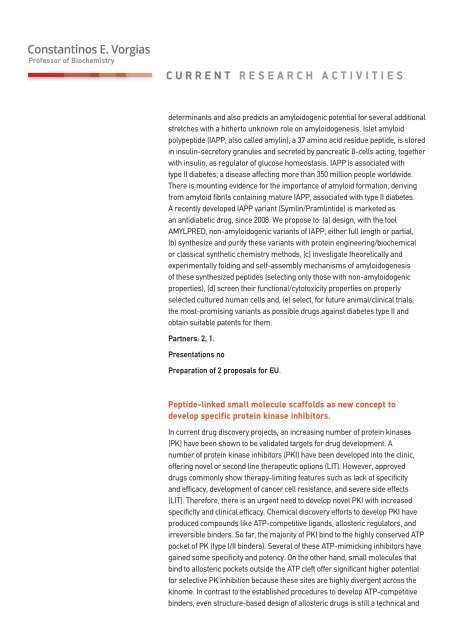Constantinos E. Vorgias PhD - Faculty of Biology
Constantinos E. Vorgias PhD - Faculty of Biology
Constantinos E. Vorgias PhD - Faculty of Biology
You also want an ePaper? Increase the reach of your titles
YUMPU automatically turns print PDFs into web optimized ePapers that Google loves.
<strong>Constantinos</strong> E. <strong>Vorgias</strong><br />
pr<strong>of</strong>essor <strong>of</strong> Biochemistry<br />
CUrrENT rESEArCH ACTIVITIES<br />
determinants and also predicts an amyloidogenic potential for several additional<br />
stretches with a hitherto unknown role on amyloidogenesis. Islet amyloid<br />
polypeptide (IAPP, also called amylin), a 37 amino acid residue peptide, is stored<br />
in insulin-secretory granules and secreted by pancreatic β-cells acting, together<br />
with insulin, as regulator <strong>of</strong> glucose homeostasis. IAPP is associated with<br />
type II diabetes, a disease affecting more than 350 million people worldwide.<br />
There is mounting evidence for the importance <strong>of</strong> amyloid formation, deriving<br />
from amyloid fibrils containing mature IAPP, associated with type II diabetes.<br />
A recently developed IAPP variant (Symlin/Pramlintide) is marketed as<br />
an antidiabetic drug, since 2008. We propose to: (a) design, with the tool<br />
AMYLPRED, non-amyloidogenic variants <strong>of</strong> IAPP, either full length or partial,<br />
(b) synthesize and purify these variants with protein engineering/biochemical<br />
or classical synthetic chemistry methods, (c) investigate theoretically and<br />
experimentally folding and self-assembly mechanisms <strong>of</strong> amyloidogenesis<br />
<strong>of</strong> these synthesized peptides (selecting only those with non-amyloidogenic<br />
properties), (d) screen their functional/cytotoxicity properties on properly<br />
selected cultured human cells and, (e) select, for future animal/clinical trials,<br />
the most-promising variants as possible drugs against diabetes type II and<br />
obtain suitable patents for them.<br />
Partners: 2, 1.<br />
Presentations no<br />
Preparation <strong>of</strong> 2 proposals for EU.<br />
peptide-linked small molecule scaffolds as new concept to<br />
develop specific protein kinase inhibitors.<br />
In current drug discovery projects, an increasing number <strong>of</strong> protein kinases<br />
(PK) have been shown to be validated targets for drug development. A<br />
number <strong>of</strong> protein kinase inhibitors (PKI) have been developed into the clinic,<br />
<strong>of</strong>fering novel or second line therapeutic options (LIT). However, approved<br />
drugs commonly show therapy-limiting features such as lack <strong>of</strong> specificity<br />
and efficacy, development <strong>of</strong> cancer cell resistance, and severe side effects<br />
(LIT). Therefore, there is an urgent need to develop novel PKI with increased<br />
specificity and clinical efficacy. Chemical discovery efforts to develop PKI have<br />
produced compounds like ATP-competitive ligands, allosteric regulators, and<br />
irreversible binders. So far, the majority <strong>of</strong> PKI bind to the highly conserved ATP<br />
pocket <strong>of</strong> PK (type I/II binders). Several <strong>of</strong> these ATP-mimicking inhibitors have<br />
gained some specificity and potency. On the other hand, small molecules that<br />
bind to allosteric pockets outside the ATP cleft <strong>of</strong>fer significant higher potential<br />
for selective PK inhibition because these sites are highly divergent across the<br />
kinome. In contrast to the established procedures to develop ATP-competitive<br />
binders, even structure-based design <strong>of</strong> allosteric drugs is still a technical and


